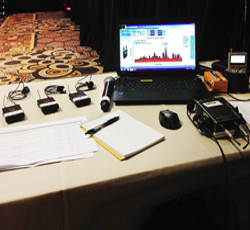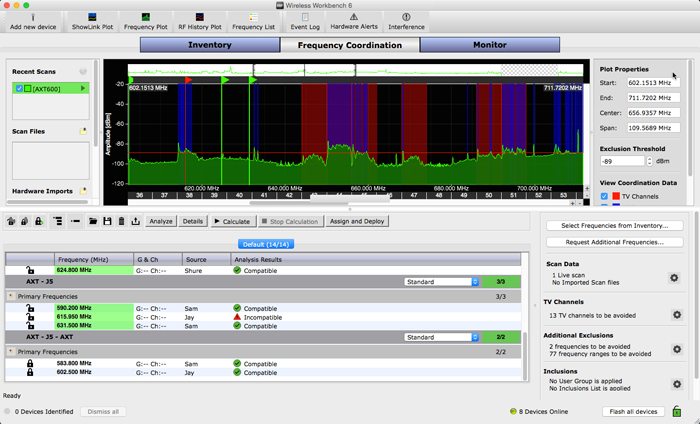Wireless systems are a key component in almost every facet of live entertainment production, especially concerts and corporate meetings and events. The demand continues to increase as the supply of available bandwidth is both shrinking and becoming more congested.
As a result, pre-planning and wireless frequency coordination are becoming more important, particularly as the FCC (Federal Communications Commission) is preparing to sell off more of the UHF spectrum where the majority of wireless microphones and monitoring systems operate (currently 470-698 MHz in the U.S.).
And, our systems already share portions of the broadcast spectrum with ever-proliferating TV band devices (TVBDs, formerly known as white space devices, or WSDs).
Add the problems of intermodulation interference (intermod) into the mix, and as audio professionals, we really need to focus on frequency coordination and wireless system design. Intermod happens when two (or more) transmitter signals mix in an active device (transmitter, active antenna, active splitter, receiver) and produce additional frequencies above and below each original transmitting frequency. These intermod products occur at the same spacing as the two original frequencies were apart.
Let’s say you need three wireless systems onstage – two mic systems and a guitar system. You select 498.000 MHz for one of the mic systems and 499.000 MHz for the other mic system. The spacing between the frequencies is 1 MHz, so don’t place the guitar system on 497.000 MHz or 500.000 MHz because that’s where the third-order intermod products will occur.
This is simple enough to figure out for a few systems, but every time another frequency is added, it must be coordinated with every other frequency in service. It gets pretty complicated on bigger gigs, and astronomically so on larger events where there can be hundreds of frequencies in use.
Modern Developments
There are several software programs that we can turn to for help with frequency coordination. Some are free, such as Sennheiser Intermodulation and Frequency Management software that provides rapid calculation of intermod-free frequencies, and Shure Wireless Workbench, with recently released version 6.11 also offering several new features to help manage wireless system performance over the network, from pre-show planning to live performance monitoring. RF Guru from Stage Research and IAS (Intermodulation Analysis System) from Professional Wireless Systems are two more programs that can help, available for a fee.
To make sure our wireless systems don’t get stepped on by TV transmitters and other high-power users (and/or cause any interference to them), we can turn to several websites that can help us steer clear of problems. The Shure Wireless Frequency Finder is a free tool where users can input their location, with the program selecting frequency bands and offering information on know TV transmitters in that region. Electro-Voice and Sennheiser are two more manufacturers that offer this kind of online help. Along with intermod calculations, the aforementioned software programs also pull in data from the FCC on active TV stations.
One way that manufacturers have adapted to the shrinking spectrum is to make their systems more efficient, with several systems now able to operate within the same amount of bandwidth that used to be occupied by a single system. For example, the Shure ULXD system can operate up to 47 active transmitters in one 6 MHz TV channel space (or 63 in one 8 MHz TV channel in high-density mode).
















